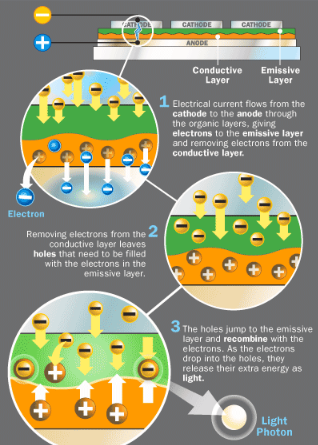To see details on working of OLED's click here
From DolceraWiki
Working of OLED'S
- OLEDs emit light in a similar manner to LEDs, through a process called electrophosphorescence.
- The process is as follows:
- The battery or power supply of the device containing the OLED applies a voltage across the OLED.
- An electrical current flows from the cathode to the anode through the organic layers (an electrical current is a flow of electrons).
- The cathode gives electrons to the emissive layer of organic molecules.
- The anode removes electrons from the conductive layer of organic molecules. (This is the equivalent to giving electron holes to the conductive layer.)
- At the boundary between the emissive and the conductive layers, electrons find electron holes.
- When an electron finds an electron hole, the electron fills the hole (it falls into an energy level of the atom that's missing an electron).
- When this happens, the electron gives up energy in the form of a photon of light (see How Light Works).
- The OLED emits light.
- The color of the light depends on the type of organic molecule in the emissive layer. Manufacturers place several types of organic films on the same OLED to make color displays.
- The intensity or brightness of the light depends on the amount of electrical current applied: the more current, the brighter the light.[source]
